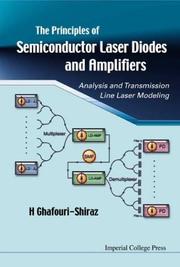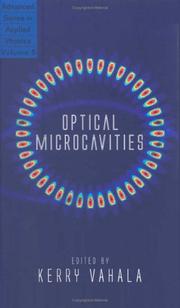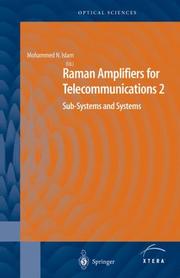| Listing 1 - 10 of 17 | << page >> |
Sort by
|

ISBN: 1281347426 9786611347420 1860944566 9781860944567 9781860943393 186094339X 1860943411 9781281347428 Year: 2004 Publisher: London Imperial College Press
Abstract | Keywords | Export | Availability | Bookmark
 Loading...
Loading...Choose an application
- Reference Manager
- EndNote
- RefWorks (Direct export to RefWorks)
Optical communications technology is growing increasingly in importance, with a rapid pace of development. Innovative optical devices have emerged from the integration of semiconductor laser diodes, amplifiers and filters with optical waveguide technology. This well-researched volume traces the evolution of semiconductor laser amplifiers (SLAs) from these technologies. Focusing on the principle applications of SLAs, the author illustrates the growing importance of these functional components in the future of optical communications systems.
Semiconductor lasers. --- Optical amplifiers. --- Diodes, Semiconductor. --- Crystal diodes --- Diodes, Crystal --- Semiconductor diodes --- Semiconductors --- Amplifiers, Optical --- Light amplifiers --- Optoelectronic devices --- Lasers

ISBN: 3527403647 9783527403646 Year: 2004 Publisher: New York (N.Y.): Wiley,
Abstract | Keywords | Export | Availability | Bookmark
 Loading...
Loading...Choose an application
- Reference Manager
- EndNote
- RefWorks (Direct export to RefWorks)
Optics --- Lasers --- Photonics --- Optique --- Photonique --- Lasers. --- Nonlinear optics. --- Photonics. --- New optics --- Physics --- Light --- Light amplification by stimulated emission of radiation --- Masers, Optical --- Optical masers --- Light amplifiers --- Light sources --- Optoelectronic devices --- Nonlinear optics --- Optical parametric oscillators
Periodical
Abstract | Keywords | Export | Availability | Bookmark
 Loading...
Loading...Choose an application
- Reference Manager
- EndNote
- RefWorks (Direct export to RefWorks)
Optics. Quantum optics --- Lasers --- Lasers. --- lasers --- uitrusting --- equipment --- technologie --- technology --- Physics (General) --- Fysica (algemeen) --- Light amplification by stimulated emission of radiation --- Masers, Optical --- Optical masers --- Light amplifiers --- Light sources --- Optoelectronic devices --- Nonlinear optics --- Optical parametric oscillators

ISBN: 3540241108 9786610412365 1280412364 3540272135 Year: 2004 Publisher: Berlin ; New York : Springer,
Abstract | Keywords | Export | Availability | Bookmark
 Loading...
Loading...Choose an application
- Reference Manager
- EndNote
- RefWorks (Direct export to RefWorks)
Ultrafast Phenomena XIV presents the latest advances in ultrafast science, including ultrafast laser and measurement technology as well as studies of ultrafast phenomena. Pico-, femto-, and atosecond processes relevant in physics, chemistry, biology and engineering are presented. Ultrafast technology is now having a profound impact within a wide range of applications, among them imaging, material diagnostics, and transformation and high-speed optoelectronics. This book summarizes results presented at the 14th Ultrafast Phenomena Conference and reviews the state of the art in this important and rapidly advancing field.
Laser pulses, Ultrashort --- Picosecond pulses --- Industrial applications --- Picosecond phenomena --- Pulses, Picosecond --- Ultrafast phenomena --- Physics. --- Optics, Lasers, Photonics, Optical Devices. --- Natural philosophy --- Philosophy, Natural --- Physical sciences --- Dynamics --- Lasers. --- Photonics. --- New optics --- Optics --- Light amplification by stimulated emission of radiation --- Masers, Optical --- Optical masers --- Light amplifiers --- Light sources --- Optoelectronic devices --- Nonlinear optics --- Optical parametric oscillators

ISBN: 0824755693 0824759893 0429139187 9786611094942 1281094943 0203970578 Year: 2004 Publisher: New York (N.Y.) Dekker
Abstract | Keywords | Export | Availability | Bookmark
 Loading...
Loading...Choose an application
- Reference Manager
- EndNote
- RefWorks (Direct export to RefWorks)
Revealing the fundamental mechanics that control light beam deflection, this text explores the latest technological developments in the field, as well as highlighting its applications.
Lasers. --- Optical scanners. --- Scanning systems. --- Imaging systems. --- Laser recording. --- Laser-beam recording --- Recording, Laser --- Imaging systems --- Optical data processing --- Optical storage devices --- Radar --- Remote sensing --- Television --- Scanning systems --- Scanners --- Optoelectronic devices --- Laser recording --- Light amplification by stimulated emission of radiation --- Masers, Optical --- Optical masers --- Light amplifiers --- Light sources --- Nonlinear optics --- Optical parametric oscillators --- Equipment and supplies

ISBN: 1281347809 9786611347802 9812565736 9789812565730 9789812387752 9812387757 9812387757 9781281347800 6611347801 Year: 2004 Volume: v. 5 Publisher: Singapore Hackensack, N.J. World Scientific
Abstract | Keywords | Export | Availability | Bookmark
 Loading...
Loading...Choose an application
- Reference Manager
- EndNote
- RefWorks (Direct export to RefWorks)
Optical microcavities are structures that enable confinement of lightto microscale volumes. The universal importance of these structureshas made them indispensable to a wide range of fields. This importantbook describes the many applications and the related physics,providing both a review and a tutorial of key subjects by leadingresearchers from each field.
Lasers. --- Electrooptics. --- Quantum electrodynamics. --- Electromagnetic interactions. --- Interactions, Electromagnetic --- Nuclear reactions --- Electrodynamics, Quantum --- QED (Physics) --- Quantum field theory --- Schwinger action principle --- Electro-optics --- Optics --- Light amplification by stimulated emission of radiation --- Masers, Optical --- Optical masers --- Light amplifiers --- Light sources --- Optoelectronic devices --- Nonlinear optics --- Optical parametric oscillators

ISBN: 1280189339 9786610189335 0387217975 0387408363 Year: 2004 Volume: 93 Publisher: New York, NY : Springer-Verlag New York, Inc.,
Abstract | Keywords | Export | Availability | Bookmark
 Loading...
Loading...Choose an application
- Reference Manager
- EndNote
- RefWorks (Direct export to RefWorks)
Fundamentals of Semiconductor Lasers explains the physics and fundamental characteristics of semiconductor lasers with regards to systems applications. The detailed and comprehensive presentation is unique in that it encourages the reader to consider different semiconductor lasers from different angles. Emphasis is placed on recognizing common concepts such operating principles and structure, and solving problems based on individual situations. The treatment is enhanced by an historical account of advances in semiconductor lasers over the years, discussing both those ideas that have both persisted over the years and those that have faded out. The first four chapters cover the basics of semiconductors, including band structures, optical transitions, optical waveguides, and optical resonators. The remaining chapters discuss operating principles and basic characteristics of semiconductor lasers, and advanced topics including dynamics single-mode lasers, quantum well lasers, and control of spontaneous emission. The reader need only be familiar with undergraduate-level electromagnetism and quantum mechanics. After reading this book, the student will be able to think critically about semiconductor lasers, and be able to read and understand journal papers in the field. This book will be essential to any advanced undergraduate or graduate student of semiconductor lasers, and any professional physicist or engineer looking for a good overview of the subject.
Electronic books. -- local. --- Lasers. --- Semiconductor lasers. --- Semiconductor lasers --- Engineering & Applied Sciences --- Applied Physics --- Lasers à semiconducteurs --- EPUB-LIV-FT SPRINGER-B --- Physics. --- Optical materials. --- Electronic materials. --- Optics, Lasers, Photonics, Optical Devices. --- Optical and Electronic Materials. --- Optics --- Materials --- Photonics. --- Electronic materials --- New optics --- Light amplification by stimulated emission of radiation --- Masers, Optical --- Optical masers --- Light amplifiers --- Light sources --- Optoelectronic devices --- Nonlinear optics --- Optical parametric oscillators --- Microwaves.

ISBN: 1280189312 9780387215859 9786610189311 0387406565 0387215859 9780387215853 9781280189319 9780387406565 Year: 2004 Publisher: New York, NY : Springer,
Abstract | Keywords | Export | Availability | Bookmark
 Loading...
Loading...Choose an application
- Reference Manager
- EndNote
- RefWorks (Direct export to RefWorks)
I remember vividly the ?rst time that I heard about the ?ber ampli?er. At that time, of course, it was the erbium-doped ?ber ampli?er, the predecessor of the Raman ampli?er that is the subject of this book. It was an early morning in a forgotten year in Murray Hill, New Jersey at one of our Bell Labs monthly research staff meetings. About twenty directors and executive directors of research organizations clustered around a long table in the imposing executive conference room. Arno Penzias, the vice president of research, presided at the foot of the table. Everyone who participated in those research staff meetings will long remember their culture and atmosphere. Arno would pick an arbitrary starting point somewhere around the table, and the designated person would head to the front of the table to give a short talk on “something new” in his or her research area. This ?rst speaker would invariably ?ddle helplessly with the controls embedded in the podium that controlled the viewgraph projector, but eventually we would hear machinery grinding in the back room as a large hidden mirror moved into place. We would all wait quietly, arranging and choosing our own viewgraphs from the piles that lay on the table in front of every participant.
Fiber optics. --- Telecommunication. --- Microwaves. --- Communications Engineering, Networks. --- Optics, Lasers, Photonics, Optical Devices. --- Microwaves, RF and Optical Engineering. --- Hertzian waves --- Electric waves --- Electromagnetic waves --- Geomagnetic micropulsations --- Radio waves --- Shortwave radio --- Electric communication --- Mass communication --- Telecom --- Telecommunication industry --- Telecommunications --- Communication --- Information theory --- Telecommuting --- Electrical engineering. --- Lasers. --- Photonics. --- Optical engineering. --- Mechanical engineering --- New optics --- Optics --- Light amplification by stimulated emission of radiation --- Masers, Optical --- Optical masers --- Light amplifiers --- Light sources --- Optoelectronic devices --- Nonlinear optics --- Optical parametric oscillators --- Electric engineering --- Engineering --- Optical communications. --- Raman effect. --- Optical amplifiers.

ISBN: 1280188987 9786610188987 0387007512 0387215832 Year: 2004 Publisher: New York, NY : Springer New York : Imprint: Springer,
Abstract | Keywords | Export | Availability | Bookmark
 Loading...
Loading...Choose an application
- Reference Manager
- EndNote
- RefWorks (Direct export to RefWorks)
I remember vividly the ?rst time that I heard about the ?ber ampli?er. At that time, of course, it was the erbium-doped ?ber ampli?er, the predecessor of the Raman ampli?er that is the subject of this book. It was an early morning in a forgotten year in Murray Hill, New Jersey at one of our Bell Labs monthly research staff meetings. About twenty directors and executive directors of research organizations clustered around a long table in the imposing executive conference room. Arno Penzias, the vice president of research, presided at the foot of the table. Everyone who participated in those research staff meetings will long remember their culture and atmosphere. Arno would pick an arbitrary starting point somewhere around the table, and the designated person would head to the front of the table to give a short talk on “something new” in his or her research area. This ?rst speaker would invariably ?ddle helplessly with the controls embedded in the podium that controlled the viewgraph projector, but eventually we would hear machinery grinding in the back room as a large hidden mirror moved into place. We would all wait quietly, arranging and choosing our own viewgraphs from the piles that lay on the table in front of every participant.
Fiber optics. --- Optical communications. --- Raman effect. --- Optical amplifiers. --- Telecommunication. --- Microwaves. --- Communications Engineering, Networks. --- Optics, Lasers, Photonics, Optical Devices. --- Microwaves, RF and Optical Engineering. --- Hertzian waves --- Electric waves --- Electromagnetic waves --- Geomagnetic micropulsations --- Radio waves --- Shortwave radio --- Electric communication --- Mass communication --- Telecom --- Telecommunication industry --- Telecommunications --- Communication --- Information theory --- Telecommuting --- Electrical engineering. --- Lasers. --- Photonics. --- Optical engineering. --- Mechanical engineering --- New optics --- Optics --- Light amplification by stimulated emission of radiation --- Masers, Optical --- Optical masers --- Light amplifiers --- Light sources --- Optoelectronic devices --- Nonlinear optics --- Optical parametric oscillators --- Electric engineering --- Engineering
Periodical
Abstract | Keywords | Export | Availability | Bookmark
 Loading...
Loading...Choose an application
- Reference Manager
- EndNote
- RefWorks (Direct export to RefWorks)
Physics --- Lasers --- Physique --- Periodicals. --- Périodiques --- Lasers. --- Physics. --- Telecommunications Technology --- General and Others --- Cables & Optical Fibres --- Digital Signal Processing --- Natural philosophy --- Philosophy, Natural --- Light amplification by stimulated emission of radiation --- Masers, Optical --- Optical masers --- Physical sciences --- Dynamics --- Light amplifiers --- Light sources --- Optoelectronic devices --- Nonlinear optics --- Optical parametric oscillators --- Electricity & Magnetism --- Physic --- Continuous Wave Lasers --- Pulsed Lasers --- Q-Switched Lasers --- Masers --- Continuous Wave Laser --- Laser --- Laser, Continuous Wave --- Laser, Pulsed --- Laser, Q-Switched --- Lasers, Continuous Wave --- Lasers, Pulsed --- Lasers, Q-Switched --- Maser --- Pulsed Laser --- Q Switched Lasers --- Q-Switched Laser --- Optical Tweezers --- Laser Therapy --- Physique. --- physics.
| Listing 1 - 10 of 17 | << page >> |
Sort by
|

 Search
Search Feedback
Feedback About UniCat
About UniCat  Help
Help News
News